Recent trends in LLMs for 2025. Chapter 4
Real-Time Data Integration and Automated Verification in Large Language Models (LLMs)
7/21/20254 min read


Chapter 4: Real-Time Data Integration and Automated Verification in Large Language Models (LLMs)
4.1 Introduction
For Large Language Models (LLMs) to maintain their relevance and accuracy in a dynamic environment, it is crucial that they can access and utilize up-to-date real-time data. Traditionally, LLMs operate with static information resulting from prior training with a closed corpus, which entails significant limitations in the face of recent changes or ephemeral information. In 2025, this is changing with the integration of new systems and techniques that allow LLMs to query external data dynamically, verify the truthfulness of information, and improve the quality of their responses.
This capability is essential for applications in journalism, finance, automated assistance, or any field where timeliness and verification are vital. We will next explore the main technologies for dynamic data integration, the challenges they face, as well as systems and methodologies that ensure the accuracy and reliability of the generated responses.
4.2 Integrated Models with Dynamic Retrieval: The RAG Technique (Retrieval-Augmented Generation)
One of the most innovative techniques for combining the generative capabilities of LLMs with real-time information retrieval is called RAG (Retrieval-Augmented Generation).
The principle is simple but powerful: when a response is requested, the system first performs a search in databases, APIs, or search engines, retrieves current and relevant documents or fragments, and then incorporates them as additional context so that the LLM generates an informed and updated response.
This hybrid architecture overcomes limitations inherent to models trained on data up to a cutoff point, enabling responses with enhanced factual accuracy, reduced misinformation propagation, and adaptation to new events or data.
Some relevant points about RAG:
Retrieval mechanisms: Use of vector searches, semantic indexing, and connectivity with specific APIs.
Continuous updating: The consulted database can be constantly updated, ensuring freshness.
Use cases: Real-time customer support, answering questions about recent news, specific document queries, financial data analysis.
Challenges: Query speed, management of multiple sources, verification of source quality. (Medium), (Fluid AI)
4.3 Integration Systems and Architectures for Real-Time Data
Modern LLMs integrate with different types of sources and services through specific architectures that support smooth and scalable integration:
4.3.1 Connection with Live Search Engines
Some systems allow LLMs to execute queries on public or custom search engines, retrieving and analyzing results to generate current responses. Examples include browser plugins or search APIs linked directly to the model.
This approach maintains flexibility and scalability but requires robust mechanisms to select relevant results and filter unreliable or erroneous information.
4.3.2 Specialized Databases and Custom Collections
Platforms like LlamaIndex (formerly GPT Index) enable building custom semantic indexes over specific organizational or domain data collections, facilitating precise queries for industries requiring highly specialized knowledge.
Updating and synchronizing these indexes with new entries is key to ensuring validity and timeliness of responses. (Milvus)
4.3.3 Open Data Sources, APIs, and Streams
In some applications, LLMs connect to public or private APIs that provide streaming or near real-time data, such as stock prices, sports results, weather events, or news. This continuous flow requires designing robust architectures for fast ingestion and systems for caching or dynamic filtering to optimize queries.
4.4 Automated Verification and Quality Control of Responses
The capacity to generate text based on dynamic data can introduce risks of errors or false information. Therefore, by 2025, complex verification and quality assurance systems have been developed:
4.4.1 Automatic Fact-Checking
The system automatically assesses the truthfulness of generated information by comparing it with verified databases, official documents, or through cross-semantic analysis in reliable sources.
It is common to use multiple steps: initial generation, cross-verification, and correction or alerting in case of inconsistency.
4.4.2 Step-by-Step Verification Methods
A growing approach consists of generating explicit explanatory reasoning about how the LLM arrived at a conclusion, which are then evaluated by formal expert systems or humans to ensure validity.
This method involves translating complex descriptions into formal specifications or delegating reasoning to specialized tools that confirm or refute the answer.
4.4.3 Testing and Monitoring in Production
Commercial applications integrate automated systems with periodic manual evaluations to detect deviations, erroneous data, or unsafe responses in real-time. Specific metrics measure accuracy, relevance, coherence, and safety.
These systems allow triggering alerts or dynamically adjusting the model or integrated data sources upon detected deviations. (Patronus AI)
4.5 Management of Data and Model Drift
When input data or the environment change over time, the quality and accuracy of an LLM may decrease if it does not adapt. This phenomenon, known as drift, is particularly critical when working with real-time data.
To mitigate it:
Continuous monitoring of the distribution and characteristics of received data.
Periodic retraining or fine-tuning of the model with new representative data.
Early detection techniques are applied to proactively react to deviations. (Nexla), (Orq)
4.6 LLM Agent Architectures: Coordination with External Tools
Recent advances have promoted LLMs acting as autonomous agents that interact with external tools, databases, and expert systems through formal specifications, orchestrating multiple steps and queries to solve complex tasks.
These agents can translate tasks into API commands, evaluate results with formal logic, and optimize processing chains to improve causal and contextual accuracy. (arXiv)
4.7 Notable Applications of Real-Time Integration
Intelligent assistants in customer support: Responses based on up-to-date data on inventories, offers, and policies.
Financial analysis: Reports and forecasts based on the latest trends and stock values.
Journalism and content generation: Creation of articles or summaries with confirmed facts and recent data.
Legal and medical systems: Consultation of updated regulations or clinical guidelines in real-time for reliable advice.
In sum, real-time data integration together with advanced verification techniques has transformed LLMs into more powerful, reliable, and adaptable tools to current needs, positioning them as a key component in artificial intelligence systems requiring high accuracy and timeliness.
